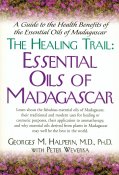
Book
Reviews
Book 25

by
Copyright © Tony Burfield 2004
Unfortunately, this in my judgement is by far the
poorest book I have so far reviewed in this mini Book Review series. The
introduction states that the purpose of the book was to introduce essential oils
from Madagascar to Aromatherpists and Health Care professionals. However only
nine “essential oils” are described from this large island and of the nine,
only six of those are true essential oils – Vanilla extracts, Calophyllum
inophyllum and Centella asiatica extract are not essential
oils, as most aromatherapists will be aware.
Of the rest Geranium, Sweet Basil, Cinnamon, Ginger and
Ylang-ylang essential oils are extremely well known everyday materials
for aromatherapists and not exclusive to Madagascar.
Further, the author makes a case that the ethnic
peoples of the forest need an income from these aromatic raw materials – and
whilst this may well be true, I’m not going argue this point here - Madagascar
for example is the worlds largest supplier of Vanilla and the work of Madagascar's
National Center for the Application of Pharmaceutical Research, in collaboration
with the UN Development Programme has been instrumental in attempting to
increase the export potential of essential oils and oleoresins. The
revenue contribution from aromatherapy oil sales is going to be relatively
small, especially with this chosen selection of high volume perfumery &
flavouring oils, and so the exact purpose of this 172-page book is
therefore not at all clear to me.
Secondly, a number of essential oil companies
operate from Madagascar, offering oils such as ambrette seed, Cedrelopsis
grevei, Croton anisatum, lemongrass (Cymbopogon citratus), palmarosa
(Cymbopogon martinii),
Eucalyptus citriodora, Hedychium
coronarium, Helichrysum bracteatum, Helichrysum gymnocephalum, Melaleuca
quinquenervia, Michaelia champaca, Psiada
altissima,
Pteronia
incana,
Schinus
terebinthifolius,
clove oil
(Syzygium
aromaticum),
vetiver (Vetiveria zizanoides) to
name but a few not mentioned in the book. Instead just one
company is recommended for purchasing essential oils listed: Lemur 2000 Inc. –
Phael-Flor USA – which lists twenty Malagasy essential oils, offering oils
such as Lantana camara and Tagetes oil, which again do not figure in the
text. The Healing Trail (courtesy of Lemur Tours) also gets a brief chapter to
itself in the book. I simply do not understand why the author, who is professor
emeritus of medicine and nutrition at the University of California at Davis, has
not provided us with a broad choice of Malagasy oil suppliers and touring
companies rather than a single operative.
Chapter one is an introduction to Madagascar and
briefly deals with its’ flora & fauna and history. Halpern attempts to
make a case for buying Malagasy essential oils, but fails to put both sides of
the argument. Chapter two “Introducing essential oils and aromatherapy”
confuses CO2 extracts and essential oils, contains the advice:
suppliers should know precisely from which plants or plants their oils are made
is not apparently followed later in the text. Under the ylang ylang section we
are told that ylang ylang oil is obtained from Cananga odorata and
Cananga oil from Cananga adoratum (in fact Canangium
adoratum (Lam.) Baill.
is the old disused botanical name for Cananga). It would be more helpful &
correct to have used the modern botanical classifications such as Cananga
odorata (DC) Hook. f. et Thoms subsp. genuina
for ylang ylang oil and Cananga
odorata (Lam.) Hook f. and Thoms. subsp. macrophylla
for cananga oil. Chemistry similarly does not seem to be a strong point as we
have on page 93 under the chemistry of ginger that the citrals are geranoil
(should be geranial), limonene (plain wrong!) and neral (this one is correct!).
By
the time I had read chapter 4 on Ravintsara, which I personally think has
confused the situation between Ravintsara and Ravensara oils even more (see Aromatherapy
Times
Summer 2004 for a definitive explanation) I was ready to quit. I’m not sure of
the role of Peter Weverka in compiling the book. According to the back cover he
has book titles in the For
Dummies
series. But by now I have decided that this book isn’t going to get a place in
my private collection.